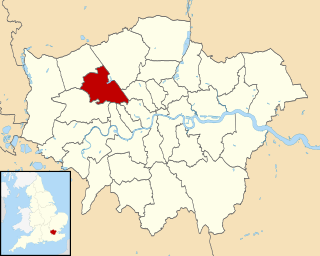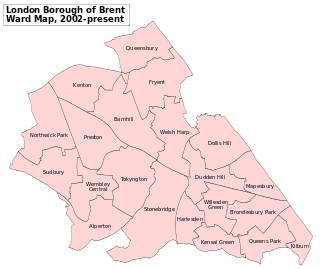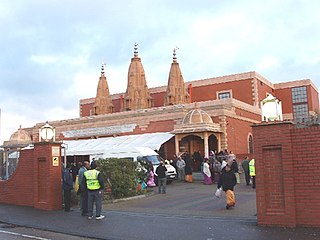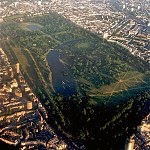Kenton is a district in north-west London, England, to the east of Harrow and historically in Middlesex. As with surroundings in Harrow, Wembley and Kingsbury, the area was a product of Metroland suburbia of the early 20th century. Both the London and North Western Railway and Metropolitan Railway reached the area by the 1920s. The main road through Kenton, the east-west Kenton Road, is a busy and important road that links Harrow to the major Edgware Road. The road now forms the boundary between the London boroughs of Harrow and Brent.
Kingsbury is a district of northwest London in the London Borough of Brent. Its ancient scope stretches to include various distinct areas that were once small villages until the inter-war period. Kingsbury was in 2001 a ward and in 2011 was identifiable with the Fryent and Barnhill wards approximately. Today it forms a quiet suburb between Fryent Country Park to the west and the Brent Reservoir to the east, along with a Jubilee line tube station and accompanying shopping district on the western side. The postal district is NW9 which it shares with Colindale and West Hendon.
Neasden is a suburban area in northwest London, England. It is located around the centre of the London Borough of Brent and is within the NW2 (Cricklewood) and NW10 (Willesden) postal districts. Neasden is near Wembley Stadium, the Welsh Harp, and Gladstone Park; the reservoir and River Brent marks its boundaries with Kingsbury and Wembley, while Gladstone Park and the Dudding Hill line separates it from Dollis Hill and Church End respectively. The A406 North Circular Road runs through the middle of Neasden; to the west is the Neasden Underground Depot, Brent Park retail area and the St Raphael's Estate; on the east is Neasden tube station, the large Neasden Temple, and former Neasden Power Station. The area is known as the place where Bob Marley lived after moving from Jamaica, living at a house in The Circle; the house was honoured with a blue plaque in 2012.

The London Borough of Brent is a London borough in north-west London. It borders the boroughs of Harrow to the north-west, Barnet to the north-east, Camden to the east, the City of Westminster to the south-east, as well as the Royal Borough of Kensington and Chelsea, Hammersmith and Fulham and Ealing to the south. Most of the eastern border is formed by the Roman road Watling Street, which is now the modern A5.
Wembley (/ˈwɛmbli/) is a largely suburban town in north-west London, England in the ceremonial county of Greater London and the historic county of Middlesex. It is about 8 miles (13 km) west-northwest of Charing Cross, and includes the neighbourhoods of Alperton, North Wembley, Preston, Sudbury, Tokyngton, and the partly high-rise district of Wembley Park. The population of the seven wards that approximately make it up totalled 102,856 as of 2011.

Wembley Park is a district of the London Borough of Brent, England. It is roughly centred on Bridge Road, a mile northeast of Wembley town centre and 7.6 miles (12 km) northwest from Charing Cross.

Brent North is a constituency represented in the House of Commons of the UK Parliament since 1997 by Barry Gardiner of the Labour Party.

Wembley was an urban district and later a municipal borough in Middlesex, England from 1894 to 1965.

The London Borough of Brent, an Outer London borough to the north west of the conurbation, has about 100 parks and open spaces within its boundaries. These include recreation and sports grounds, a large country park, and a large reservoir. The main areas of open space are:

The Brent Reservoir is a reservoir in North West London. It straddles the boundary between the boroughs of Brent and Barnet and is owned by the Canal & River Trust. The reservoir takes its informal name from a public house called The Welsh Harp, which stood nearby until the early 1970s. It is a 68.6-hectare (170-acre) biological Site of Special Scientific Interest (SSSI), the only SSSI in either borough and among more than 30 SSSIs in Greater London.

Brent London Borough Council in London, England is elected every four years. Since the last boundary changes in 2002, 63 councillors have been elected from 21 wards.

Sudbury is a suburb in the London Borough of Brent, located in northwest London, United Kingdom. The suburb forms the western part of Wembley and is centred around 0.6 miles (1 km) west of Wembley Central railway station.

Queensbury is an area of northwest London, England, in the southeast of the London Borough of Harrow on the boundary with the London Borough of Brent. The area is split between four postal districts: Harrow HA3, Stanmore HA7, Edgware HA8, and London NW9.

Preston is a small locality in northwest London. It forms part of the London Borough of Brent and the northern part of Wembley. It is a residential suburb containing Preston Road Station with some stores on either side. The area to the station's north is covered under the HA3 postcode and is, along with the area around South Kenton station to the west, normally considered part of Kenton.

Fryent Country Park, together with Barn Hill Open Space, is a large park situated in the north of the London Borough of Brent. It covers 103 hectares of rolling fields and small woods.

Northwick Park is a large green public park between Harrow and Kenton in north-west London, forming part of the London Borough of Brent. Most of the park consists of playing fields. It is also the name of the electoral ward of Brent that covers the park, the area around its namesake station, and most of North Wembley.

Shri Kutch Satsang Swaminarayan Temple (Harrow) is a Swaminarayan Temple in the London Borough of Harrow. When opened in 1976, the temple was originally located at Vaughan Road, West Harrow. It was moved to the Kenton area of Harrow in 1996 to accommodate the growing congregation. The temple comes under the NarNarayan Dev Gadi of the Swaminarayan Sampraday.

Chalkhill Estate is located in the Wembley Park area of North West London. It was originally one of three large council estates built in the London Borough of Brent by the early 1970s, along with Stonebridge and South Kilburn. The design was based on that of Park Hill in Sheffield. The high-rise estate was demolished by 2000 and gradually replaced by new low-rise builds.
The 1968 Brent Council election took place on 9 May 1968 to elect members of Brent London Borough Council in London, England. The whole council was up for election and the Conservative party gained overall control of the council.
















